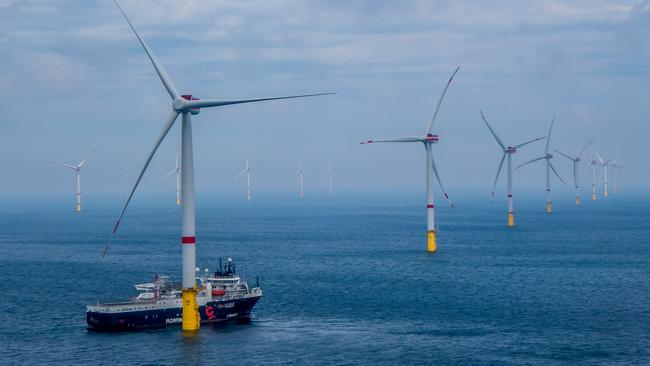
For many people, particularly those living in rural and regional areas, this sounded more like a dystopian nightmare than a desirable nirvana. And it still does, as the federal and state governments, aided by self-serving renewable energy investors, seek to override the legitimate rights of landowners and folk living in country areas.
It’s a case of sticks and carrots, with more compulsion than persuasion. There are truncated environmental approvals processes, faux consultations, staged town meetings, ministerial directives. There is talk about obtaining social licence but this is just for show.
Those directly affected by having massive turbines, fields of industrial-scale solar panels and high-voltage transmission lines on their land may be offered an annual annuity for the inconvenience subject to refraining from making any criticism of the installations or renewable energy in general. Affected neighbours may be offered small amounts of compensation, but this is also subject to a gag order. It’s hard to escape the conclusion city folk either don’t know about what has been happening in our regions or don’t care. If similar tactics were imposed on them, there would be an almighty uproar. The fact these imposed renewable energy zones – imposed at the behest of the renewable energy companies themselves – cover largely conservative seats, at federal and state level, is also an important consideration.

Economists have long understood not every private market transaction fully accounts for all the costs and benefits. The difference is referred to external costs and benefits. Of course, in the case of renewable energy investment, it is hardly a case of unfettered private transactions. Investors are given various subsidies, including the ongoing benefits of Renewable Energy Certificates as well as direct subsidies from both state and federal governments. It is an extremely featherbedded industry that would hardly exist absent this favourable treatment.
(The Prime Minister’s constant refrain that renewable energy is the cheapest form of generation is clearly tosh. If this were really the case, unassisted renewable energy would simply drive out all other forms of generation. This is clearly not the case.) The point is that the external costs imposed on rural and regional communities are overwhelmingly ignored when making the case for the expansion of renewable energy. There is no attempt to estimate the size of these external costs. This is the case in the recently released, but highly dubious, Integrated System Plan devised by the Australian Energy Market Operator.
To be sure, there is passing mention of the need to obtain social licence but it’s in the context of foisting wind farms, solar panels and new transmission lines on rural and regional communities irrespective of the preferences of the locals. The “greater good” is to reduce emissions even though the contribution of Australia, let alone any regional area, to lowering global emissions is infinitesimal.

(By the way, the recent AEMO ISP is a terrifying slanted document. It mixes up net present values with today’s capital costs; it treats the costs of all projects, current, committed and anticipated, as sunk; household costs are excluded; its assumptions about the cost of transmission are far too low. The estimated cost of $122bn to achieve net zero has zero credibility. The public should be highly concerned this agency is setting the agenda for our energy future.)
In effect, we simply expect rural and regional communities to take it on the chin, often by pitting neighbour against neighbour. There are multiple stories of communities rend asunder because of the renewable energy caravan coming to town. There is the loss of arable land, the loss of physical amenity, the loss of local flora and fauna, the massive disruption caused during the construction phase. But these issues are dramatically downplayed by the ardent advocates of renewable energy.
A similar story applies to immigration and the failure to account for its external costs, particularly in relation to housing. The proponents of large migrant intakes – and this includes the Labor government and the Coalition, at least in the past – take the view that these external costs can simply be dismissed because the benefits of immigration are so large. Dubious studies are undertaken to assess the net economic benefits of immigration but fail to account for the external costs.
It is ironic that these studies typically show only small positive net economic benefits that are generally only realised after two decades or so. It is clear, however, that the migrants themselves benefit, as do the owners of capital. Think here property developers, big business and educational institutions.

As for the external costs, there is sometimes reference to congestion, pressure on public services, loss of social cohesion and the impact on housing affordability. But it is extremely rare to see any numbers attached to these external costs because they would need to be subtracted from any estimates of the small net benefits.
Just as is the case with renewable energy, the winners from high rates of immigration, particularly the universities, think certain segments of society should simply wear these external costs because of some ill-defined greater good.
Promoting exports is a common rationale as well as bumping up the international rankings of our universities. Bear in mind here that the universities, with their substantial international student enrolments, pay no tax that might otherwise offset some of these external costs.
The link between immigration and the shortage of housing also leads directly to housing policies to which many local residents also object. High-density housing is promoted even if this involves overriding the preferences of those living in the affected areas.
The pejorative term NIMBY is used to undermine the legitimate property rights of homeowners who have purchased property along with an implicit assurance that the nature of the precinct is largely retained. Increasingly, state governments are wont to override the planning responsibilities of local governments in order to promote the type of housing that can cope with a rapidly growing population caused mainly by immigration.

In some instances, state governments have insisted that high-rise apartments are built without any carparking, leading to an explosion of cars being parked on local streets. This is another example of an external cost being imposed on residents who previously enjoyed relatively uncrowded streets.
The big picture here is that optimal government policies always require an assessment of the full costs and benefits including external costs. Increasingly, however, single-minded policies have been guided by a paternalistic view of the paths to the greater good – via promotion of renewable energy, high migrant intakes, high-density housing – with nary a thought for those adversely affected.
Indeed, in some cases, those folk hurt by the policies are denigrated in the name of ramming through bad policies. It’s only when the losers opt to fight back is there a chance of more balanced policy. The revolts we are seeing in some regional and rural areas about the placement of intrusive renewable energy installations and transmission lines may be just the beginning. Politicians may need to take heed.
More Coverage
 It’s a case of sticks and carrots, with more compulsion than persuasion. There are truncated environmental approvals processes, faux consultations, staged town meetings, ministerial directives.
It’s a case of sticks and carrots, with more compulsion than persuasion. There are truncated environmental approvals processes, faux consultations, staged town meetings, ministerial directives.






In 2023, former chief scientist Alan Finkel wrote glowingly about “forests of wind farms carpeting hills and cliffs from sea to sky (and) endless arrays of solar panels disappearing like a mirage into the desert”.